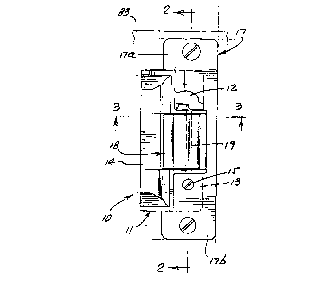Some of the information on this Web page has been provided by external sources. The Government of Canada is not responsible for the accuracy, reliability or currency of the information supplied by external sources. Users wishing to rely upon this information should consult directly with the source of the information. Content provided by external sources is not subject to official languages, privacy and accessibility requirements.
Any discrepancies in the text and image of the Claims and Abstract are due to differing posting times. Text of the Claims and Abstract are posted:
| (12) Patent Application: | (11) CA 2228194 |
|---|---|
| (54) English Title: | BOLT CLOSURE MAINTENANCE FOR FIRE-DEGRADED LATCHING ASSEMBLY |
| (54) French Title: | DISPOSITIF DE VERROUILLAGE DE PENE ACTIVE PAR UN INCENDIE |
| Status: | Deemed Abandoned and Beyond the Period of Reinstatement - Pending Response to Notice of Disregarded Communication |
| (51) International Patent Classification (IPC): |
|
|---|---|
| (72) Inventors : |
|
| (73) Owners : |
|
| (71) Applicants : |
|
| (74) Agent: | GOWLING WLG (CANADA) LLP |
| (74) Associate agent: | |
| (45) Issued: | |
| (22) Filed Date: | 1998-01-28 |
| (41) Open to Public Inspection: | 1998-08-18 |
| Examination requested: | 2002-04-15 |
| Availability of licence: | N/A |
| Dedicated to the Public: | N/A |
| (25) Language of filing: | English |
| Patent Cooperation Treaty (PCT): | No |
|---|
| (30) Application Priority Data: | ||||||
|---|---|---|---|---|---|---|
|
In a door closure assembly, the combination
comprising a latch bolt element; carrier structure to
carry the bolt element to pivot between door unlatched
and latched position; and means carried by a fire
resistant portion of the assembly to be responsive to
an increase in temperature to a level T to move into
position to block door unlatching movement of the bolt
element from door latching position.
Verrou de porte comprenant : un pêne; un dispositif de déplacement permettant de faire pivoter le pêne d'une position déverrouillée à une positIon verrouillée; et un dispositif, logé dans une partie du verrou résistante au feu, qui réagit à une augmentation de température, lorsque celle-ci atteint une valeur T, en se déplaçant de manière à bloquer le pêne pour l'empêcher de passer à la position déverrouillée.
Note: Claims are shown in the official language in which they were submitted.
Note: Descriptions are shown in the official language in which they were submitted.

2024-08-01:As part of the Next Generation Patents (NGP) transition, the Canadian Patents Database (CPD) now contains a more detailed Event History, which replicates the Event Log of our new back-office solution.
Please note that "Inactive:" events refers to events no longer in use in our new back-office solution.
For a clearer understanding of the status of the application/patent presented on this page, the site Disclaimer , as well as the definitions for Patent , Event History , Maintenance Fee and Payment History should be consulted.
| Description | Date |
|---|---|
| Inactive: IPC from MCD | 2006-03-12 |
| Application Not Reinstated by Deadline | 2005-01-28 |
| Time Limit for Reversal Expired | 2005-01-28 |
| Deemed Abandoned - Failure to Respond to Maintenance Fee Notice | 2004-01-28 |
| Letter Sent | 2002-05-29 |
| Amendment Received - Voluntary Amendment | 2002-04-15 |
| Request for Examination Received | 2002-04-15 |
| All Requirements for Examination Determined Compliant | 2002-04-15 |
| Request for Examination Requirements Determined Compliant | 2002-04-15 |
| Application Published (Open to Public Inspection) | 1998-08-18 |
| Inactive: IPC assigned | 1998-05-27 |
| Inactive: IPC assigned | 1998-05-27 |
| Inactive: First IPC assigned | 1998-05-27 |
| Classification Modified | 1998-05-27 |
| Amendment Received - Voluntary Amendment | 1998-05-08 |
| Inactive: Filing certificate - No RFE (English) | 1998-04-22 |
| Application Received - Regular National | 1998-04-22 |
| Abandonment Date | Reason | Reinstatement Date |
|---|---|---|
| 2004-01-28 |
The last payment was received on 2003-01-13
Note : If the full payment has not been received on or before the date indicated, a further fee may be required which may be one of the following
Patent fees are adjusted on the 1st of January every year. The amounts above are the current amounts if received by December 31 of the current year.
Please refer to the CIPO
Patent Fees
web page to see all current fee amounts.
| Fee Type | Anniversary Year | Due Date | Paid Date |
|---|---|---|---|
| Application fee - standard | 1998-01-28 | ||
| Registration of a document | 1998-01-28 | ||
| MF (application, 2nd anniv.) - standard | 02 | 2000-01-28 | 1999-12-07 |
| MF (application, 3rd anniv.) - standard | 03 | 2001-01-29 | 2000-12-20 |
| MF (application, 4th anniv.) - standard | 04 | 2002-01-28 | 2001-12-17 |
| Request for examination - standard | 2002-04-15 | ||
| MF (application, 5th anniv.) - standard | 05 | 2003-01-28 | 2003-01-13 |
Note: Records showing the ownership history in alphabetical order.
| Current Owners on Record |
|---|
| ADAMS RITE MANUFACTURING CO. |
| Past Owners on Record |
|---|
| ALAN K. UYEDA |